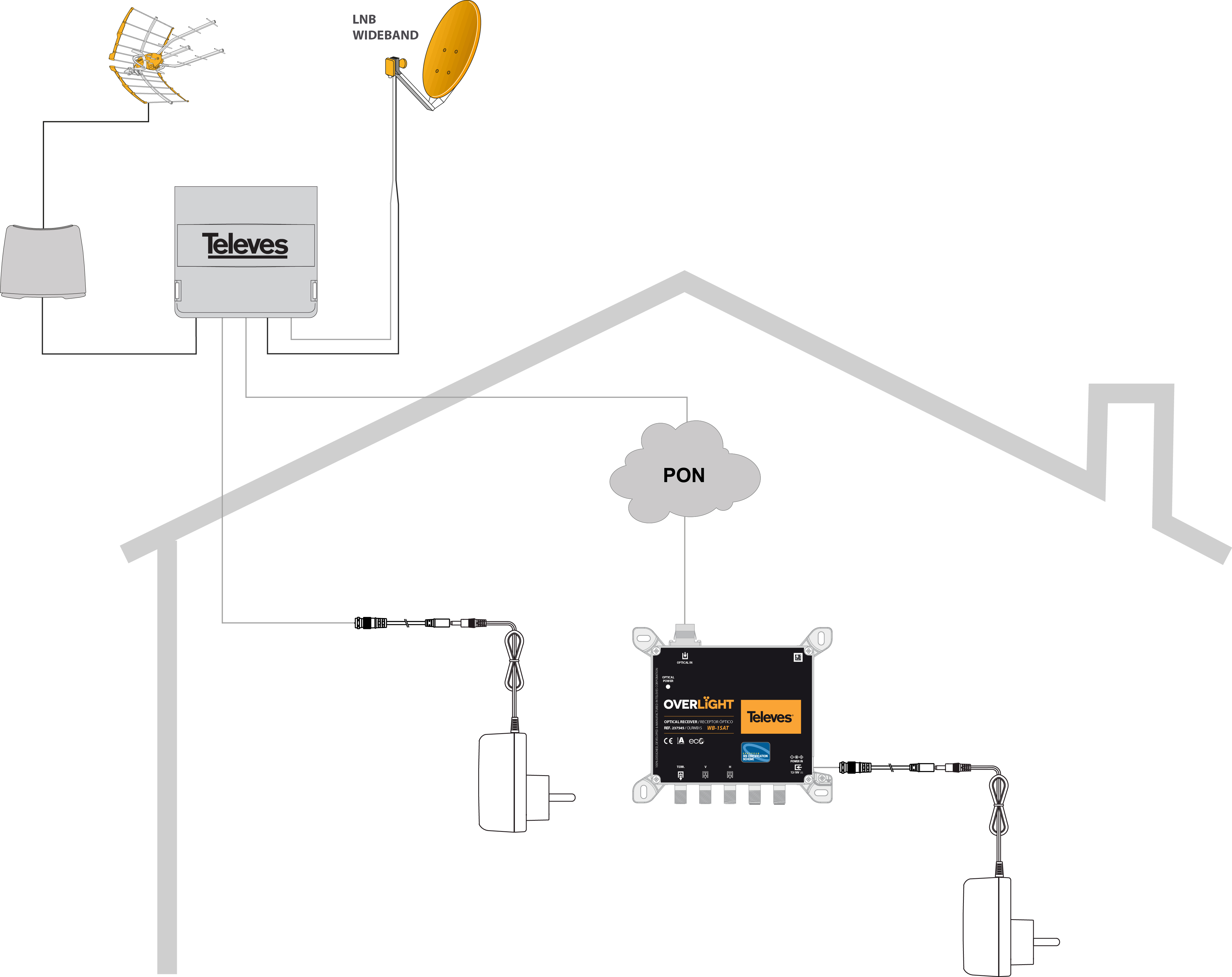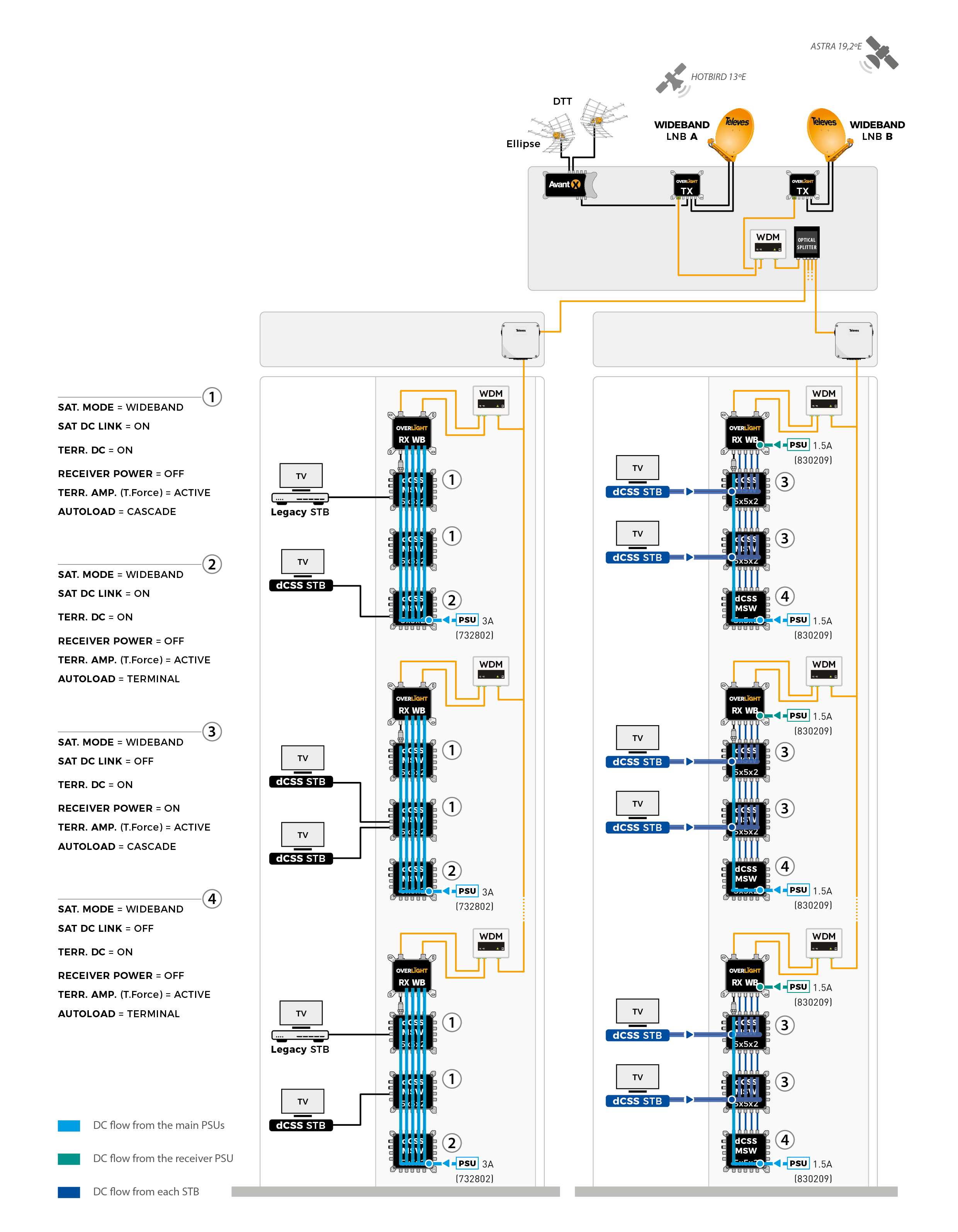Overlight WideBand Optical Receiver with 1 SAT+TERR input and 1 WB output + 1 TERR output, OLC integrated
Enhanced electronics and optical engineering to light up your TV
Optical Wideband satellite and terrestrial receiver with OLC technology. Designed to capture the TV optical signal from 1 satellite on a single fiber (1200...1600 nm) and restore the original terrestrial and satellite TV signals, providing 1 Wideband output and 1 terrestrial output.
Thanks to its optimized electronics and low losses, it allows to reduce the number of amplifiers required and simplifies deployment in the design of collective installations, preserving the signal quality throughout the process.
This device is part of the Overlight system, that distributes satellite and terrestrial signals to multiple users through a single optical fiber.
- Very compact in dimensions and weight (137x120x30 mm)
- Low losses
- Built-in OLC (Optical Level Control) system: automatically adjusts the parameters to achieve a constant output level, irrespective of the channel load
- Optimized electronic behavior
- 100% european design, quality, and manufacturing
- SC/APC optical connector
- F-type RF connectors
- High-screening Zamak chassis
- Can be wall-mounted using screws
- LED indicator displaying signal status
- Remote power feeding using V-H or an external PSU
- Low power consumption
WideBand technology
WideBand (also known as FullBand) refers to broadband transmission technology that uses a wide range of frequencies. In WideBand TV systems, a substantial portion or the whole of the frequency spectrum is available to users. It can be used in fiber deployments where long cable runs are demanded, or coaxial scenarios in combination with multiswitches adapted to this technology.
In WideBand technology, an LNB captures a complete satellite signal and distributes it through 2 universal outputs (vertical -V- and horizontal -H-), each of them with the combination of high (H) and low (L) bands, in a frequency range between 290 and 2340 MHz.
Despite the fact that Quattro technology is the most widely deployed technology in TV systems nowadays, WideBand technology brings significant advantages to the installation:
- Simpler, faster and cleaner installation: In WideBand technology the number of coaxial cables connecting the LNB to the multiswitches is half as in traditional Quattro deployments, so the installation is done quicker and easier. The installation will also be tidier with fewer cables.
- Wider bandwidth than other technologies: WideBand channels can carry more information thanks to their wide bandwidth (290-2340MHz). This powerful feature allows a greater number of services to be delivered to the end users of the installation.
- Reusable deployment: WideBand technology allows signal distribution by reusing a Quattro installation. It can be distributed through the old 4 cables coming down from the roof to capture signals from up to 2 satellites, changing only LNBs and MSWs to be WideBand compatible.
| Number of outputs | 3 | ||||
|---|---|---|---|---|---|
| TERR number of outputs | 1 | ||||
| Number of outputs V | 1 | ||||
| Number of outputs H | 1 | ||||
| Inputs/Bands |
| ||||
| Output frequency range | MHz |
| |||
| Output level | dBµV |
| |||
| Input wavelength | nm | 1200 ... 1600 | |||
| Optical input power | dBm | -11 ... -1 | |||
| Optical return losses | dB | > 40 | |||
| Optical receiving device | InGaAs PIN photodiode | ||||
| Optical connectors | SC/APC | ||||
| RF connectors | "F" female | ||||
| Impedance | Ω | 75 | |||
| Powering | Vdc | 12 ... 18 | |||
| Max current consumption (@12V) | mA | 370 | |||
| Max current consumption (@18V) | mA | 246 | |||
| PSU input voltage | Vac | 100 ... 240 | |||
| Max PSU current input | mA | 600 | |||
| PSU output voltage | Vdc | 12 | |||
| Max PSU output current | A | 1.5 | |||
| PSU protection index | 23 | ||||
| PSU operating temperature | °C | -5 ... 45 | |||
| Operating temperature | °C | -5 ... 45 |
These measurements are conditioned to the use of an Overlight transmitter
Physical data
Net weight: 381 g
Gross weight: 502 g
Width: 138 mm
Height: 125 mm
Depth: 45 mm
Main product weight: 381 g
Packing
Box 1 Units
| tlv_discontinued | No | |||||||||||||||||||||||||||||||||||||||||||||||||||||||||||||||||||||||||||||||||
|---|---|---|---|---|---|---|---|---|---|---|---|---|---|---|---|---|---|---|---|---|---|---|---|---|---|---|---|---|---|---|---|---|---|---|---|---|---|---|---|---|---|---|---|---|---|---|---|---|---|---|---|---|---|---|---|---|---|---|---|---|---|---|---|---|---|---|---|---|---|---|---|---|---|---|---|---|---|---|---|---|---|---|
| tlv_tags | WideBand technologyWideBand (also known as FullBand) refers to broadband transmission technology that uses a wide range of frequencies. In WideBand TV systems, a substantial portion or the whole of the frequency spectrum is available to users. It can be used in fiber deployments where long cable runs are demanded, or coaxial scenarios in combination with multiswitches adapted to this technology. In WideBand technology, an LNB captures a complete satellite signal and distributes it through 2 universal outputs (vertical -V- and horizontal -H-), each of them with the combination of high (H) and low (L) bands, in a frequency range between 290 and 2340 MHz. Despite the fact that Quattro technology is the most widely deployed technology in TV systems nowadays, WideBand technology brings significant advantages to the installation:
|
|||||||||||||||||||||||||||||||||||||||||||||||||||||||||||||||||||||||||||||||||
| tlv_slogan | Enhanced electronics and optical engineering to light up your TV | |||||||||||||||||||||||||||||||||||||||||||||||||||||||||||||||||||||||||||||||||
| tlv_reflog | OLRWB1S | |||||||||||||||||||||||||||||||||||||||||||||||||||||||||||||||||||||||||||||||||
| tlv_tabla_especificaciones |
These measurements are conditioned to the use of an Overlight transmitter |
|||||||||||||||||||||||||||||||||||||||||||||||||||||||||||||||||||||||||||||||||
| tlv_ean | 8424450298527 | |||||||||||||||||||||||||||||||||||||||||||||||||||||||||||||||||||||||||||||||||
| tlv_dim_product_x | 138 | |||||||||||||||||||||||||||||||||||||||||||||||||||||||||||||||||||||||||||||||||
| tlv_dim_product_x_label | Width | |||||||||||||||||||||||||||||||||||||||||||||||||||||||||||||||||||||||||||||||||
| tlv_dim_product_x_unit | mm | |||||||||||||||||||||||||||||||||||||||||||||||||||||||||||||||||||||||||||||||||
| tlv_dim_product_y | 125 | |||||||||||||||||||||||||||||||||||||||||||||||||||||||||||||||||||||||||||||||||
| tlv_dim_product_y_label | Height | |||||||||||||||||||||||||||||||||||||||||||||||||||||||||||||||||||||||||||||||||
| tlv_dim_product_y_unit | mm | |||||||||||||||||||||||||||||||||||||||||||||||||||||||||||||||||||||||||||||||||
| tlv_dim_product_z | 45 | |||||||||||||||||||||||||||||||||||||||||||||||||||||||||||||||||||||||||||||||||
| tlv_dim_product_z_label | Depth | |||||||||||||||||||||||||||||||||||||||||||||||||||||||||||||||||||||||||||||||||
| tlv_dim_product_z_unit | mm | |||||||||||||||||||||||||||||||||||||||||||||||||||||||||||||||||||||||||||||||||
| tlv_weight_product_label | Main product weight | |||||||||||||||||||||||||||||||||||||||||||||||||||||||||||||||||||||||||||||||||
| tlv_weight_product | 381 | |||||||||||||||||||||||||||||||||||||||||||||||||||||||||||||||||||||||||||||||||
| tlv_weight_product_unit | g | |||||||||||||||||||||||||||||||||||||||||||||||||||||||||||||||||||||||||||||||||
| tlv_gross_weight_label | Gross weight | |||||||||||||||||||||||||||||||||||||||||||||||||||||||||||||||||||||||||||||||||
| tlv_gross_weight | 502 | |||||||||||||||||||||||||||||||||||||||||||||||||||||||||||||||||||||||||||||||||
| tlv_gross_weight_unit | g | |||||||||||||||||||||||||||||||||||||||||||||||||||||||||||||||||||||||||||||||||
| tlv_net_weight_label | Net weight | |||||||||||||||||||||||||||||||||||||||||||||||||||||||||||||||||||||||||||||||||
| tlv_net_weight_unit | g | |||||||||||||||||||||||||||||||||||||||||||||||||||||||||||||||||||||||||||||||||
| tlv_net_weight | 381 | |||||||||||||||||||||||||||||||||||||||||||||||||||||||||||||||||||||||||||||||||
| tlv_1_type_pack | Box | |||||||||||||||||||||||||||||||||||||||||||||||||||||||||||||||||||||||||||||||||
| tlv_1_type_pcs_pack | Units | |||||||||||||||||||||||||||||||||||||||||||||||||||||||||||||||||||||||||||||||||
| tlv_1_pcs_pack | 1 |
-
AutoCAD drawing
237545_CAD11230001.dwg
(0.93 MB) -
Product release brochure
BRO_OVERLIGHT_EN-TUK_APRIL_2025_PLA07240013.pdf
(11.22 MB) -
Product release brochure
BRO_OVERLIGHT_EN-TME_APRIL_2025_PLA07240013.pdf
(11.24 MB) -
Technical specifications
technical_specifications_en_US_TEC02240092_237545.pdf
(0.11 MB) -
Product Sheet
237545_en_US_product_sheet_PSH02240008_237545.pdf
(0.22 MB) -
Declaration of Conformity
DOC09240022_0_237545.pdf
(0.22 MB) -
Data sheet
DS11230010_000_ES-EN-FR-IT-DE-PL-PT-ENUS_237545_237546.pdf
(2.31 MB)




